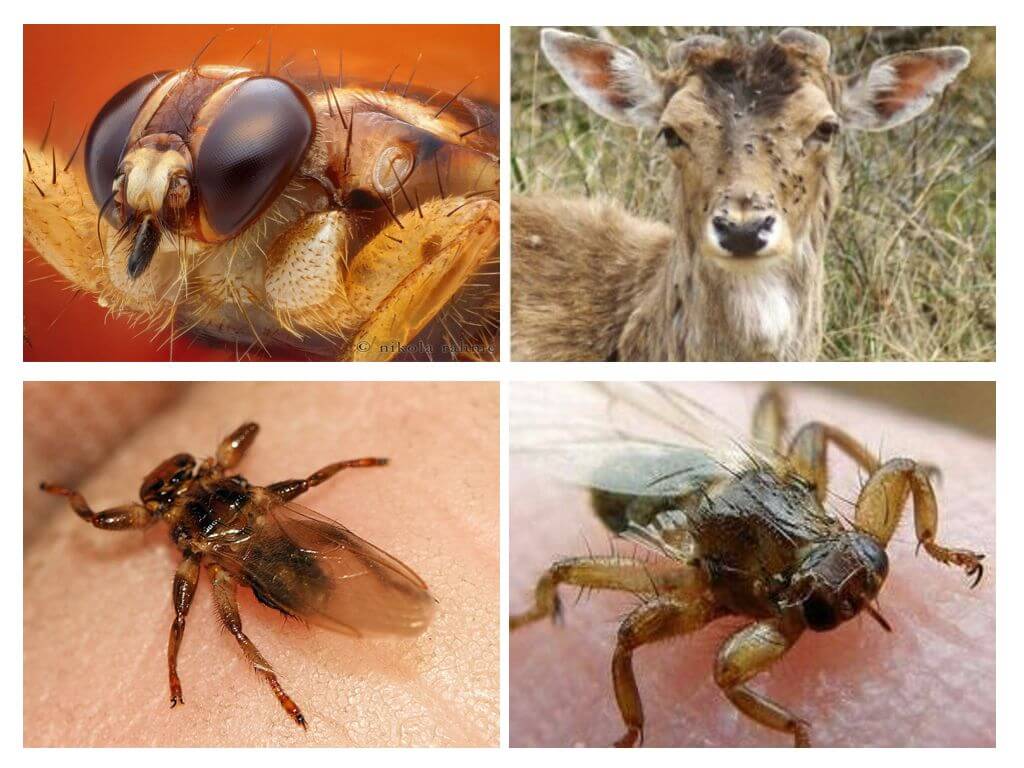- Elk Lice
- Animal pest
- Lice bites
People who love hiking trips or hiking in the forest for mushrooms do not bother to find out that there they can expect not only pleasant experiences, but also bloodsucking insects. Pests such as mosquitoes and ticks, but there are some unfamiliar to a wide range of tourists, for example, moose louse.
Description of elk lice
This insect has many more names: deer fly, moose tick, etc., which it received due to the names of animal breadwinners: moose, deer, deer. They can also settle in the wool of smaller animals (bears, foxes, wild boars, etc.).
On a note!
Moose lice belong to the family of bloodsuckers and are very similar to ordinary flea and ticks, which is why they are often confused with them.
The body is light brown in size 2-5 mm with three pairs of claws with claws, with which they cling to animal fur (see photo elk lice). These insects have wings, although they rarely use them and the proboscis, through which blood is sucked. They use wings 5-6 mm long only when searching for a new host, and then drop them and bury themselves in the animal’s hair.
On the head of such a louse there are 2 large eyes, occupying almost a quarter of its volume, but additionally 3 more ordinary eyes (you can see this in the photo).

Distributed over a large territory of the European part of Russia, Siberia, northern China, in the Scandinavian and North American countries. On one animal, 200-1000 of these parasites can settle.
Life cycle
Elk lice live in pairs, the fertilized female carries an egg in herself, in which a chrysalis develops after a certain time, then the larva. After 16-18 days, she gives birth to a 3-4 mm larva, called a pre-pupa, which after 2 hours turns into a puparia. The next chrysalis is born in a couple of days, during its life the female manages to give birth to 20-30 larvae.
Puparia with a hard shell fall on the earth's surface in the autumn-winter time (from October to March), where they are located for six months of their development until August. After that, young flies with wings hatch from the larvae (see elk lice in the photo), who are actively looking for their master and breadwinner, flying on grass and bushes. After its discovery, the flies settle in the wool, dropping wings.

Thus, the whole life cycle of elk louse lives for 5-6 months, dying in the spring after the active laying of pupae.
During its short life, the insect usually lives on one animal, under adverse circumstances (the death of the owner), moves to another. Every day, the parasite eats up to 18 times the blood of its breadwinner, sucking 1 mg per session. Due to the fact that there can be a lot of such lice on an animal, severe blood loss leads to its depletion and death.
On a note!
Most often, pests settle on forest animals, but are also found among livestock (goats, cows, sheep, etc.).
Danger from an attack by moose lice
The elk louse is dangerous only for its breadwinners - forest animals. For humans, it is less dangerous. Cases of bites of such insects are found in foresters, hunters and mushroom pickers.
The bite of elk lice is quite painful and is accompanied by inflammation and compaction, there is also severe itching, which can lead to scratching and scratching.Moose flies themselves do not spread the infection, but through a wound in bitten places a person may well bring the infection. There is also a risk for people prone to allergic diseases.
Interesting!
If such a fly clings to the skin of a person, then removing it is not easy at all because it clings tightly to the skin with its claws.
Prevention and protection against moose lice

The most reliable way to protect yourself from moose flies is to wear protective clothing in the forest: overalls or jackets with pants that should have cuffs that fit tightly to the body, tuck pants into socks and boots. It is also better to protect the head with a mosquito net or headgear. Special protective clothing models.
When hiking in the forest to repel insects use mosquito repellents or tick remedies in the form of sprays that are applied to skin and clothing. Such drugs have a wide spectrum of action and affect many blood-sucking insects.
If the insect sticks to the skin, then you can remove it in the following ways:
- using a strong thread, a loop is made, which is tightened on the body of the louse, then twisting and swinging the thread, the insect can be pulled out;
- You can remove the parasite with tweezers, only with caution so as not to tear off its upper part, because the lower one will then remain under the skin;
- using sunflower oil, with which the louse is lubricated and waiting for it to come out (15-20 minutes).
After the insect has been pulled out, the wound should be treated with an antiseptic: hydrogen peroxide, etc. A bitten itchy place can not be combed so as not to infect the infection, but it is better to use alternative methods: apply ice, tinctures of aloe and calendula, which will also relieve inflammation. In case of an allergic reaction, it is necessary to take an antihistamine.
If moose lice on the body or clothes are found after visiting the forest, then it is necessary to grind everything in hot water, thoroughly swim and wash your hair. For better protection and destruction of pests, insecticides that are used to pediculosis treatment.






